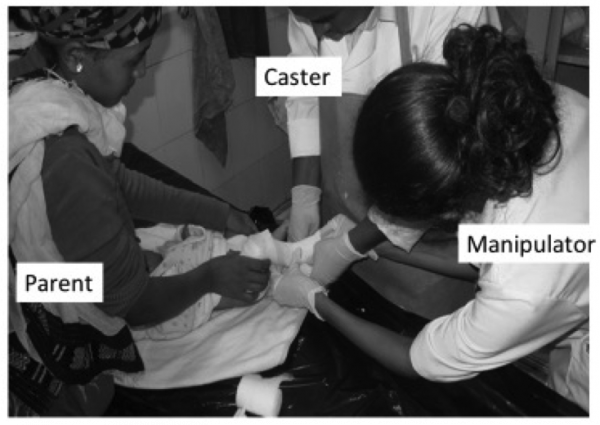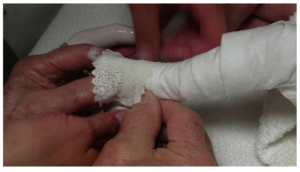Casting for Clubfoot: Difference between revisions
No edit summary |
No edit summary |
||
| Line 24: | Line 24: | ||
=== Manipulator === | === Manipulator === | ||
Position: | '''Position:''' | ||
Role: | The individual Manipulating the Foot Stands On the Lateral Side of the Foot | ||
'''Role:''' | |||
Directs Treatment | |||
Measures the Pirani Score | |||
Manipulates the Foot | |||
Determines the Position of the next cast | |||
Moulds the Cast | |||
Remember: “Assess, Plan, and Treat” <ref name=":0" /> | |||
=== Caster === | === Caster === | ||
Position: | '''Position:''' | ||
The individual Casting Stands on the Medial Side of the Foot | |||
Role: | '''Role:''' | ||
Records Pirani scor | |||
Role: | Wraps the padding and casting material onto the leg | ||
Holds the knee whilst the manipulator moulds the cast <ref name=":0" /> | |||
If the mother is sitting, the manipulator should stand on the | === Parent / Carer === | ||
'''Position:''' | |||
The parent / carer present where possible should be Breastfeeding or Feeding Baby or Standing by Baby’s Head | |||
'''Role:''' | |||
Comforts baby | |||
Keeps baby as still as possible | |||
May help to stabilize the thigh whilst the lower part of the cast is wrapped and moulded. | |||
If the mother is sitting, the manipulator should stand on the mot right if it is a right foot, and the parent/carers left if it is a left foot. The caster stands on the other side. If the mother is going to breastfeed it is best if the child sucks on the breast that is the same side as the foot, i.e. left breast for left foot <ref name=":0" /> | |||
Thus: | Thus: | ||
* Right Foot = Right | * Right Foot = Right Side for Breastfeed = Manipulator on Mother’s Right | ||
* Left Foot = Left | * Left Foot = Left Side for Breastfeed = Manipulator on Mother’s Left | ||
<blockquote>Remember: | <blockquote>Remember: <u>TWO</u> People Required To Cast <ref name=":0" /></blockquote>[[File:Position during Casting.png|none|thumb|600x600px|Positions during Casting]] | ||
== What Makes a Good Cast == | == What Makes a Good Cast == | ||
=== Communication === | === Communication === | ||
Know who is manipulating and moulding | |||
What is your aim for this cast? Know what poisiton you would like to achieve <ref name=":0" /> | |||
=== Underwrap === | === Underwrap === | ||
Each turn is overlapped by half, Creating 2 Layers | |||
Toes are covered and underwrap goes all the way up into the groin | |||
3 layers at the groin to stop rubbing | |||
Wrap Snugly <ref name=":0" /> | |||
=== Plastercast === | === Plastercast === | ||
Correct and Continuous Manipulation | |||
Footplate to Tip of the Toes | |||
Complete Below-knee Cast First | |||
Moulding Above Heel to Prevent Slipping | |||
Knee at 90 Degrees | |||
Knee Plate in Bigger Infants | |||
Plaster Goes Right up the Back of Thigh | |||
Trim Back to See Toes <ref name=":0" /> | |||
== Casting Process == | == Casting Process == | ||
=== Manipulate the Foot === | === Manipulate the Foot === | ||
Identify Lateral Head of Talus | |||
Manipulate the foot for around 60 seconds to stretch the tight ligaments | |||
Determine the desired position of the foot and communicate this to the caster <ref name=":0" /> | |||
=== Hold Foot for Caster to do Below-knee Part of Cast === | === Hold Foot for Caster to do Below-knee Part of Cast === | ||
Manipulator holds the foot by the toes using the tips of his or her thumb and index finger to prevent crowding. The manipulator’s other hand can hold the baby’s thigh as the below-knee part of the cast will be done first | |||
Manipulator keeps their fingers inside the cast, applies cast over the fingers and completely over the toes | |||
Caster Wraps Padding: 3 turns over the toes, overlap each layer by half. The padding can extend up to the top of the thigh | |||
Caster wets the cast and wraps 3 layers snugly over foot and ankle but slightly looser over the calf to prevent unnecessary pressure on the muscles | |||
Complete the below-knee part of the cast first <ref name=":0" />[[File:Casting Process - Below Knee.png|none|thumb|300x300px|Casting Process Below Knee]] | |||
=== Mould the Cast === | === Mould the Cast === | ||
Manipulator moulds the plaster gently around the foot and above the heel, keeping thumb over LHT moving so as to keep the correction but not to cause an indent. Keep moulding until cast has set. <ref name=":0" /><blockquote>Remember: | Manipulator moulds the plaster gently around the foot and above the heel, keeping thumb over LHT moving so as to keep the correction but not to cause an indent. Keep moulding until cast has set. <ref name=":0" /><blockquote>Remember: Never Touch the Heel <ref name=":0" /></blockquote> | ||
=== Complete and Trim Cast === | === Complete and Trim Cast === | ||
| Line 106: | Line 138: | ||
* Trim the cast back over the toes | * Trim the cast back over the toes | ||
* Discuss cast care with the parents <ref name=":0" /> | * Discuss cast care with the parents <ref name=":0" /> | ||
<blockquote>Remember: | <blockquote>Remember: Toe to Groin Casts <ref name=":0" /></blockquote> | ||
=== Removal of Casts === | === Removal of Casts === | ||
Revision as of 19:06, 5 November 2017
Original Editor - Africa Clubfoot Training Team as part of ICRC and GCI Clubfoot Content Development Project
Top Contributors - Naomi O'Reilly, Chelsea Mclene, Kim Jackson, Simisola Ajeyalemi, Rucha Gadgil, Meaghan Rieke and Olajumoke Ogunleye
Introduction[edit | edit source]
The application of casts is a crucial part of the correction of clubfoot deformity. The cast is needed to maintain the correction that has been achieved by manipulation. If the cast is badly put on it can slip and lose correction, it can also cause rubbing and skin breakdown. Like all skills it is best learned by practical demonstration but this chapter outlines the key points. [1]
What Do You Need?[edit | edit source]
- Pirani Scoring Sheet
- Pen
- Right Size Underwrap (usually 5cm wide)
- Right Size Plaster (usually 5cm wide in babies)
- Water
- Cover for Parents/Carers Clothes
- Foot Slab from 4 - 6 Layers of Plaster
- Knee Slab from 4 - 6 Layers of Plaster
- Scissors / Blade
- 2 Trained People:
- 1 Trained Person to Manipulate
- 1 Trained Person to Cast [1]
Roles[edit | edit source]
Manipulator[edit | edit source]
Position:
The individual Manipulating the Foot Stands On the Lateral Side of the Foot
Role:
Directs Treatment
Measures the Pirani Score
Manipulates the Foot
Determines the Position of the next cast
Moulds the Cast
Remember: “Assess, Plan, and Treat” [1]
Caster[edit | edit source]
Position:
The individual Casting Stands on the Medial Side of the Foot
Role:
Records Pirani scor
Wraps the padding and casting material onto the leg
Holds the knee whilst the manipulator moulds the cast [1]
Parent / Carer[edit | edit source]
Position:
The parent / carer present where possible should be Breastfeeding or Feeding Baby or Standing by Baby’s Head
Role:
Comforts baby
Keeps baby as still as possible
May help to stabilize the thigh whilst the lower part of the cast is wrapped and moulded.
If the mother is sitting, the manipulator should stand on the mot right if it is a right foot, and the parent/carers left if it is a left foot. The caster stands on the other side. If the mother is going to breastfeed it is best if the child sucks on the breast that is the same side as the foot, i.e. left breast for left foot [1]
Thus:
- Right Foot = Right Side for Breastfeed = Manipulator on Mother’s Right
- Left Foot = Left Side for Breastfeed = Manipulator on Mother’s Left
Remember: TWO People Required To Cast [1]
What Makes a Good Cast[edit | edit source]
Communication[edit | edit source]
Know who is manipulating and moulding
What is your aim for this cast? Know what poisiton you would like to achieve [1]
Underwrap[edit | edit source]
Each turn is overlapped by half, Creating 2 Layers
Toes are covered and underwrap goes all the way up into the groin
3 layers at the groin to stop rubbing
Wrap Snugly [1]
Plastercast[edit | edit source]
Correct and Continuous Manipulation
Footplate to Tip of the Toes
Complete Below-knee Cast First
Moulding Above Heel to Prevent Slipping
Knee at 90 Degrees
Knee Plate in Bigger Infants
Plaster Goes Right up the Back of Thigh
Trim Back to See Toes [1]
Casting Process[edit | edit source]
Manipulate the Foot[edit | edit source]
Identify Lateral Head of Talus
Manipulate the foot for around 60 seconds to stretch the tight ligaments
Determine the desired position of the foot and communicate this to the caster [1]
Hold Foot for Caster to do Below-knee Part of Cast[edit | edit source]
Manipulator holds the foot by the toes using the tips of his or her thumb and index finger to prevent crowding. The manipulator’s other hand can hold the baby’s thigh as the below-knee part of the cast will be done first
Manipulator keeps their fingers inside the cast, applies cast over the fingers and completely over the toes
Caster Wraps Padding: 3 turns over the toes, overlap each layer by half. The padding can extend up to the top of the thigh
Caster wets the cast and wraps 3 layers snugly over foot and ankle but slightly looser over the calf to prevent unnecessary pressure on the muscles
Complete the below-knee part of the cast first [1]Mould the Cast[edit | edit source]
Manipulator moulds the plaster gently around the foot and above the heel, keeping thumb over LHT moving so as to keep the correction but not to cause an indent. Keep moulding until cast has set. [1]Remember: Never Touch the Heel [1]
Complete and Trim Cast[edit | edit source]
- Cast is extended above the knee high into the groin and the knee set at 90 degrees flexion.
- The manipulator can help the caster now by holding the dried below-knee part of the cast
- The groin end of the plaster should not stray over the edge of the padding or there will be a sharp edge of plaster irritating the skin
- A footplate can be added if the plaster is weak. This is simply a flat slab of plaster about 4 - 6 layers thick that is the size of the sole of the foot and supports the sole
- A knee slab of 4 - 6 layers can also be added to the front of the cast from lower shin to upper thigh if it appears weak
- Trim the cast back over the toes
- Discuss cast care with the parents [1]
Remember: Toe to Groin Casts [1]
Removal of Casts[edit | edit source]
Babies who are in the corrective phase of treatment will need cast removal every time they attend the clinic.
- The cast is soaked in water and then the bandage can be unwound
- This should be done at the clinic rather than at home as correction can be lost
- Removal of the cast using a plaster saw is noisy and can make the baby cry
- Some casters make the removal process easier by scrunching up the last inch of each roll of plaster into a ball so that it can easily be found [1]








